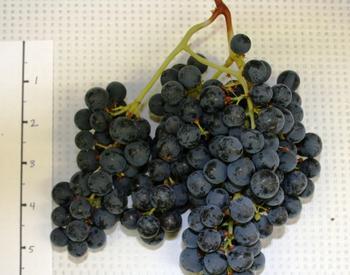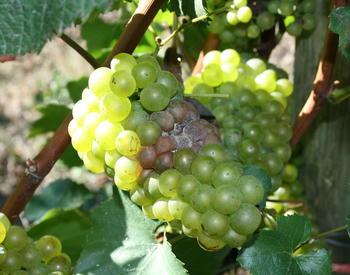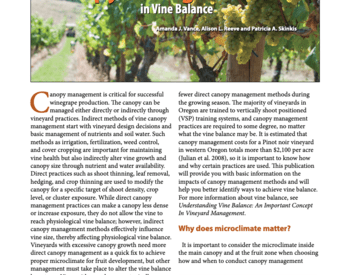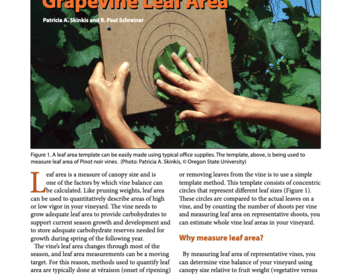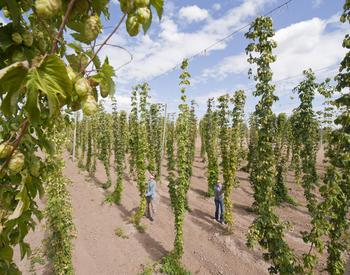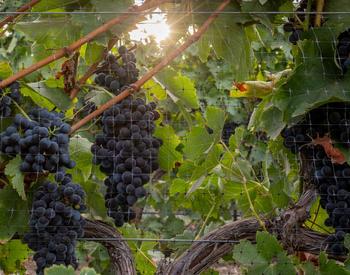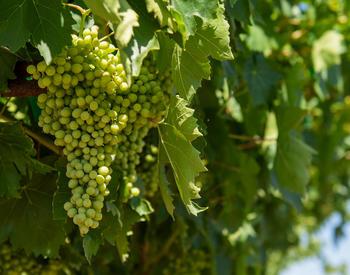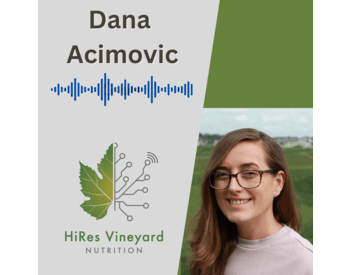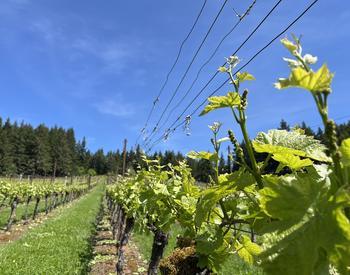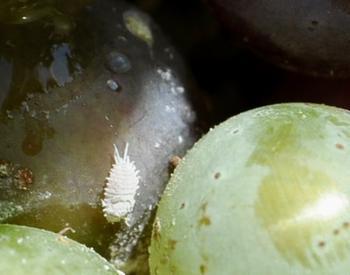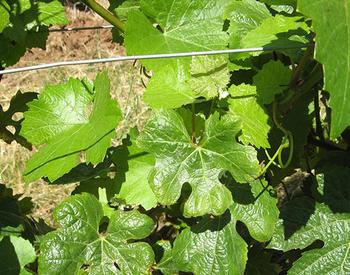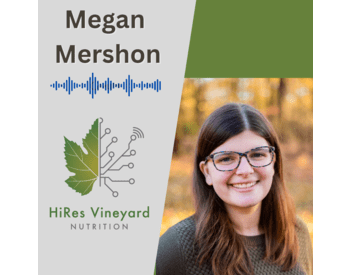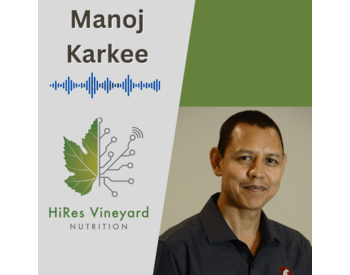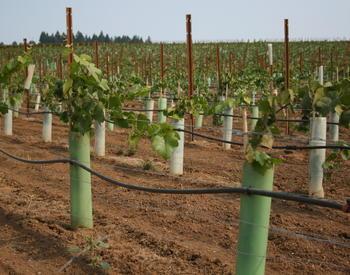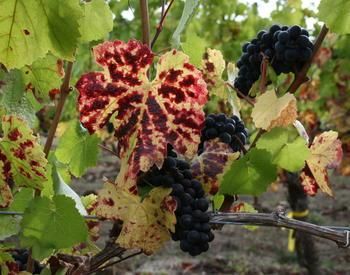Transcript
00:00 Patty Skinkis
This is the HiRes Vineyard Nutrition Podcast Series, devoted to helping the grape and wine industry understand more about how to monitor and manage vineyard health through grapevine nutrition research. I am your host, Dr. Patty Skinkis, Professor and Viticulture Extension Specialist at Oregon State University.
Nitrogen has been a major focus of our research in the HiRes Vineyard Nutrition Project, and we've talked about it for a number of our podcast episodes. We know nitrogen is important for vine growth, fruit and wine quality. What we do in the vineyard can certainly impact our nitrogen levels in the fruit. When we have nitrogen deficiency, in vineyards in particular, it's important to boost nitrogen to impact both the vine growth as well as the berry yeast assimilable nitrogen, which we know is important for fermentation and wine quality. We know quality is much more than just the yeast assimilable nitrogen or YAN, and we know that nitrogen can be having an impact that might be direct or indirect on those berry and wine quality components. When we think back to the vineyard, walking that line between having enough nitrogen or too much is often hard. We have tools that can add nitrogen including soil or foliar nitrogen products, which have to be applied at the appropriate time to get our desired outcome. Whether it's for improving plant growth, berry nitrogen or berry composition, foliar N has become an important part of YAN management in recent years, with some studies showing that you can effectively deliver nitrogen to your fruit without inducing high plant vigor.
Well, we're going to dig into that a bit deeper today by talking to Pierre Davadant, a PhD candidate and research assistant in Markus Keller’s lab at Washington State University. He's located in the Prosser Research Station, and he has been working for the past two growing seasons on field and potted vine studies to understand how nitrogen application impacts berry and wine composition, and to determine where nitrogen is going in that process.
Thank you for joining us today, Pierre.
02:20 Pierre Davadant
Thank you for having me, Patty.
2:22 Patty Skinkis
I'm really excited to hear about your research, in part because there's been some work done on nitrogen additions in the vineyard - and we know what some of those outcomes can be - but also because I really like how your project gets a bit deeper about how this is affecting berry components and not just YAN. So, it's more than just YAN, and understanding what that's doing to the plant physiology present a very exciting opportunity for us to have you talk about both your field studies and your potted vine studies. But, I want you to start out telling us a little bit about yourself and how you got started working on this project.
03:01 Pierre Davadant
I was originally born and raised in France. I lived there for 30 years and I've been working in the wine industry for more than 14 years. I have winemaking and vineyard work experiences, and I was also teaching viticulture and enology in France, in the Loire Valley, for 6 years. I really enjoyed teaching to students that were going to industry. But, I was thinking about doing some research, which was really the fuel of my teaching activity. So, I started looking for graduate programs in an English-speaking country around the world where I could do a PhD. Soon after, I got in contact with Dr. Keller, at the exact moment when the High-Resolution Vineyard Nutrition project was launched. This is the reason why I came to Washington State University.
03:58 Patty Skinkis
You started working on the nitrogen project and have been busy over the last two growing seasons, and decided to branch out and do additional projects on identifying where nitrogen is moving specifically, which I'm really excited about. I mean I'm excited about all of your research, but I am especially interested in hearing where nitrogen goes, since we don't know exactly where it goes (but we know to some extent). Can you tell us a little bit about the main questions of your research, and maybe some of the key information around how you designed the studies that you're doing?
04:33 Pierre Davadant
I have to preface that one of the biggest advantages of doing a PhD in the US is that you have a lot of freedom in how you want to construct or design your PhD program, and which questions you want to work on. So, it was like a blank page, and I was able to decide what I wanted to.
First, the focus was made on nitrogen because it's the first limiting factor for growth and development of plants. And second, there are several studies showing that YAN (yeast assimilable nitrogen) in the Pacific Northwest, and especially in Eastern Washington, was as really, really low, sometimes as low as 30 mg/L. If you think that 150 mg/L would be the required amount to have a complete alcoholic fermentation, our values seem very low. Growers have to supplement the most in the winery to have a complete alcoholic fermentation, but ideally, they prefer to have fruit that is naturally rich in YAN, since it provides more quality. So, one would think this has an easy answer. You know what-- we're just going to add a lot of nitrogen to the vineyard and so the problem is going to be fixed. However, an excess of nitrogen is impacting the vigor, and excessive vigor is extremely detrimental to quality and the ripening of grapes, so, we cannot go in that direction. The foliar application of nutrients, especially at veraison when the berry color is changing, has promoted a growing interest in the past years because it has been shown that does not impacting the vigor, plus it is important for the ripening process, and it's also improved the aromatic composition profile in the fruit and wine. In white varieties like Sauvignon Blanc, for example, this can be extremely interesting. But when using a new practice, you want to make sure that other compounds are not degraded, otherwise the main advantage becomes a problem.
Concerning phenolic compounds for red wine production, meaning anthocyanins and tannins, the results show contradictory responses with foliar applications of urea, depending of the local environment because some studies are in cool climates or different countries. So, we are testing that practice here under the conditions of dry-irrigated Eastern Washington. We started a field experiment in a commercial vineyard where we applied different levels of N to the soil at 0, 20, 40 and 80 lb per acre, at bloom. There was a control with nothing applied and a fifth treatment of foliar application of urea at veraison, equivalent to 15 lb N per acre. Very quickly we were able to see that the response in terms of YAN in the fruit and the juice was very strong. This means that a very small dose of foliar nitrogen application at veraison can really increase the YAN. So, when we think about the difference in fertilization volumes in relation to YAN increments, 15 lb per acre applied to the foliage had higher level of YAN than 80 lb applied to the soil. This (foliar application) seems to be a very efficient way to solve that issue.
08:30 Patty Skinkis
One question I have for you—was the foliar urea that you applied only applied to the cluster zone or was it applied to the entire plant?
08:39 Pierre Davadant
It was applied to the entire plant. And there's this entire question about phenolic compounds. We know that nitrate is repressing the biosynthesis of phenolic compounds, especially anthocyanins. I would say that the main underlying hypothesis is that the foliar application of urea - that is not going through the nitrate step but directly though ammonium - is then bypassing the repression of the phenolic compound biosynthesis. So, hopefully we maintaining the level of phenolic and why not maybe increasing it? Let’s be crazy, you know.
09:24 Patty Skinkis
I think that's an important thing that maybe many people don't understand in the nitrogen management aspect. We know that too much nitrogen leads to poor quality, but that's always the question, is it a direct relationship of the nitrogen or is it shading or other aspects of plant over-vigor that might lead to cropping level differences? You said there is a direct relationship of nitrate specifically suppressing the biosynthesis of anthocyanins, and that's important. So, your work is being done in a red grape variety, but I think you're also using white grapes as well. Can you mention which cultivar or varieties you're working with?
10:08 Pierre Davadant
The field experiment is being doing on Syrah, and the potted vine experiments are done on Cabernet sauvignon and Riesling, but more for isotope tracing purposes I would say, not with the focus on phenolics.
So, from that field experiment, it's important to say that wine was made from each treatment at the Wine Science Center, and really there was no significant differences in terms of phenolic compounds between all the treatments. This goes to show that the homeostasis of perennial plants is huge. So, even though you apply a treatment, you might not get a difference after several years. But, I would say that only the level of tannings in the foliar treatment was a little bit lower, and that would be it. And the other components, pruning weights, yield and berry weight were not significantly different between treatments, and same thing for the juice parameters.
11:17 Patty Skinkis
You're normally applying nitrogen in Eastern Washington. Your trial had rates of 20, 40 and 80 lb N per acre, at bloom. So, what’s the typical rate that is applied in a commercial setting on an annual basis?
11:33 Pierre Davadant
That’s always a very difficult question to answer. I would say that between 40 and 60 lb N per acre could be an average amount of nitrogen applied to the vineyards. But it really depends on the yield goals of the producer, the year, and you know, a lot of factors. However, I would say 40 or 60 (lb N/A) is a good range.
11:57 Patty Skinkis
Sure, and that's good to know for context because Pierre is talking about eastern Washington-- arid climate, and also relatively low nitrogen soils. So, it’s not necessarily recommending that 40 to 60 lb N per acre for anybody else in any other region. It is very specific to this situation.
12:18 Pierre Davadant
It is. And also, an interesting thing about irrigated agriculture in a very dry region is that drip irrigation so it has a zone that is full of water around the root zone, but the interrow and other parts of the soil may contain nitrogen, but it is not accessible by the roots because there's no soil solution. It is dry! So, when we speak about fertilization efficiency or precision viticulture, I think there's a lot of hope for foliar application of nutrient. Of course, it cannot be the main way to fertilize because the resource use by applying directly on the leaves, and so all the nutrients cannot be supplied this way, but maybe applications at veraison with this purpose could be interesting to explore.
From that field experiment, I thought that the repression caused by the nitrate on the phenolic compounds might happen before or after a threshold, but maybe it's not just a gradient and It's just happening or not—the repression. So, in the field I had no idea where we were compared to that threshold, so from that experience, we developed the potted vine experiment with Cabernet sauvignon the second year, with different rates of nitrogen applied at bloom - the same idea of what we did in the field - in a controlled environment and in a soil that was completely depleted from any nutrients. I applied 0, 0.25, 1.25 and 3.75 g of nitrate on the soil (four treatments), then the same 4 treatments with nitrogen applied at bloom, and lastly foliar application of urea at veraison based on the same field model. That included three applications at once a week. Veraison starts at the end of the lag phase and when the berries are between green-hard and the beginning of green-soft, and corresponded to the phase in which we made the first application, and then every week from that moment. The idea was to see if the consecutive N application could have an impact on the different metrics. These are recent results for me, but it is a bit inconclusive for the phenolics, and the trend is not clear. The berries were dissected, and the compounds were measured in all different berry tissues, skin, pulp and seed, but it’s hard to conclude anything from that. It seems that the effect of foliar urea on the YAN is even stronger when the vines present deficit in nitrogen, and that huge bump into YAN observed when we compare foliar application with urea, was decreasing when the dose of nitrogen was increasing, showing a gradient across the four treatments. That's an encouraging result that gives us more dimensions about the reaction of YAN.
15:47 Patty Skinkis
You said the foliar application was more responsive in terms of higher YAN when the vines were more deficient, and that makes sense because we have this challenge that we have vineyards that have good vigor - and this is speaking about Oregon Pinot noir - and certain vineyards will have good vigor, their nitrogen levels at veraison in the tissues will look normal and sufficient, but the fruit will be really low in YAN.
It doesn't relate, and we've had that trouble. I always had the sense that the nitrogen is not going all to the fruit, and of course this was observed in trials where were not applying nitrogen directly, but it makes much more sense that some vines that are already deficient might be able to put that [nitrogen] where it needs to be (berries) rather than other growth (canopy and leaves).
16:49 Pierre Davadant
You're right Patty, and also when we speak about YAN we refer to ammonium and amino acids, except proline. Yeasts cannot use proline while it can be in very high amounts, so, I think one future analysis to conduct for me is also the proline content, because maybe nitrogen is actually in the fruit, but we are just not measuring it because the yeast is not going to use it.
17:23 Patty Skinkis
That's a good point and that's the challenge. Once we get a metric, use it and it's practical, we sometimes lose sight of the bigger picture, at least from a research perspective. That's still important to understand the practical perspective.
17:41 Pierre Davadant
Exactly! So, another question from that field experiment that was slightly touched earlier was, where to spray the foliar urea, and I said the whole canopy. I asked myself that question, are the leaves absorbing as much as the fruit? We were spraying everything just for security, but which is the best practice? Is the fruit absorbing urea or are the leaves absorbing urea? And, are they doing it equally? There were so many questions about absorption and partitioning in the plant. So, from that field experiment last year, I designed another trial on Riesling. It's a small simple experiment with four treatments: a control with a classical application of urea, and three treatments containing enriched nitrogen (N-15), which is not naturally abundant like N-14, and allows us to trace where it's going in a plant. One treatment was the application of the whole plant, cluster plus leaves. The second treatment was the application only to the leaves, so the fruit was protected, and the third treatment was the application only to the fruit, so the leaves were protected. This was to understand where N was going. At the end of the trial the plants were chopped to pieces. The different tissues were separated and analyzed after, roots, trunk, canes, leaves, rachis and the berries were dissected in pulp, seeds and skin as well. A fine powder was made from those tissues, and the ratio of the N-15 over N-14 was analyzed. This way we were able to know level of enrichment in the different tissue and where was that original molecule mobilized from.
First, we had a high level of enrichment, which is very positive for us. It means the overall treatment is working. There were not significant differences between the entire plant application or just the leaves. The results are comparable--the partitioning is comparable. I would say the main finding from that research showed that the fruit absorbed a lot. So, the cluster application of urea and the partitioning showed that the fruit absorbed N-15 and that most of it stayed in the fruit. A little bit went to the roots as well, so there was some transport of nitrogen from the fruit to the root and small amounts in went to other organs too, but most of it stayed in the fruit. I think that's super interesting. If your goal is to target fruit nitrogen, then it seems that spraying the clusters zone is more efficient for that objective.
The first two treatments, were whole plant and only leaves were applied; high amounts of N-15 stayed in the leaves and went to the roots. So, if your target is to improve the storage of nitrogen, spraying leaves could be a great idea. In the end, the current practice of doing both could make sense if you want N for storage and N in the fruit. And, if I go back to the Cabernet Sauvignon experiment last year with the different levels of nitrogen, and observe the plants in the pots this year, it was very impressive to see that all the foliar treatments almost did not differ. I did not see see the gradient of increasing nitrogen, which goes actually from 0 to 3.75 g (it's times 15 amount), and you don't see that. It means that the foliar application created a lot of reserves, so the carry over effect next year imply that the plant can just pump the nitrogen from its own reserves. So, I was also able observe the conclusions from the Riesling experiment here too, which I think it's very encouraging.
22:30 Patty Skinkis
So, you had some vines left over that you didn't cut up and evaluate, that you could carry over the next year?
22:39 Pierre Davadant
Exactly! And I will also keep them until bloom, to see if that affects the number of flowers and everything.
22:48 Patty Skinkis
That's fantastic, to carry it through that second season, that's really interesting. We'll look forward to seeing more information from that project and others.
You talked a little bit about the next steps for this project. We are already into 2023 growing season--how long do you anticipate these projects you are working on to last?
23:12 Pierre Davadant
Based on the framework of my PhD, this is probably the last field season. I think we have to dig a little deeper into where that nitrogen is going. I think proline is a candidate that has to be quantified and identified, but probably the other amino acids as well. Maybe it's an amount of proteins that could be interesting, so there are different tracks that we are discussing currently, to know under which form that nitrogen is moving and where it is going. It's still building itself I would say.
23:51 Patty Skinkis
And I know other parts of the HiRes Vineyard Nutrition Project is that they have sensors that can determine tissue evaluation. It just occurred to me that I don't think we're scanning fruit to do any evaluation of nitrogen. But I know that one of the groups is looking at proteins through the short-wave infrared, and they believe that's a big part of this. So, maybe we've got something that we can take forward to see. I think it's worth considering it.
We talked about it in a group meeting yesterday. If we didn't have to do pruning weights and we could do a sensor that could do that, I think there is also some validity. And if we had a way to do a scan for protein, or a scan for YAN’s or amino acids…. I know that's probably “pie in the sky,” but it might be and additional thought that could come from this work.
24:48 Pierre Davadant
Absolutely! And also, in that highly challenging environment that is Eastern Washington, since the temperatures here are very warm. The first year I came we had two days, I remember, at 47°C (116°F), for a European person, it is a challenging environment! It’s indeed a challenging environment, in addition to water scarcity. So maybe, in that environment, there are many PR proteins that are generated in the grapes. I think there's a lot of food for thought on the protein and more detail composition work is necessary. There's a link between the phenolic compounds and nitrogen, given the entire phenylpropanoid pathway. The precursor is phenylalanine, an amino acid that suffer a deamination, so you don't find nitrogen in final phenolic compounds but in the precursor, so you cannot trace further that nitrogen. So, it should have to be a genetic study to see how the gene expression of the phenylpropanoid pathway enzymes are expressed or not, since they have been identified.
26:02 Patty Skinkis
You said earlier that you're looking at the fruit, but are the wines also being made from this project or a portion of the projects?
26:10 Pierre Davadant
Wine is only made from the commercial vineyard. The potted vine experiment is very low yielding, since plants sometimes can yield a hundred grams or less.
26:28 Patty Skinkis
That's completely understandable from the potted trial, plus I don't think we want to have N-15 enriched wines.
26:37 Pierre Davadant
Right!
26:38 Patty Skinkis
What's the plan for you? Are you interested in staying in viticulture research once you're completed with your research project? And if so, do you have any thoughts about how you might proceed in the future?
26:53 Pierre Davadant
I've been in viticulture for a very long time under different hats, as we say in French. I would really like to stay in that field. I think grapes are fantastic. I think I'm a little addicted to grapes - not wine. I have even planted two Cabernet Sauvignon in my little patio in my private property. I would also like to stay in research and academia. I love teaching, since I have been doing it for 6 years, and I really liked that. So, that's something I would really like to do, and if it is going to be under the hat of extension or more fundamental research, it's too early to say. That's the direction I'm taking.
27:45 Patty Skinkis
Very cool! So, to wrap up, I wanted to ask a fun question: What is the most interesting place you have ever visited or wish to visit and why?
27:58 Pierre Davadant
Oh wow, that's a loaded question. That I would like to visit right? I think that it would be China.
I've traveled quite a bit in Europe, North America and South America, so I've already been to some places. I really would like to visit China for the gastronomy and all the food they have. I'm a food person, I cook and bake a lot, and not just because I'm French but because I really enjoy it. Some people in France do not cook you know, and I think that Chinese have incredibly rich diverse food recipes and traditions, that are thousands of years old, and it's a big country. So, I think a little food trip would be extremely fun.
28:46 Patty Skinkis
Well, great! Thank you so much for joining us today to talk about your research, I think many will be interested enough to keeping an eye on future publications or results from this project. Of course, you don't have to wait for the publication, we’ll make sure in the HiRes Vineyard Nutrition Project that some of it's shared before that time point. But thank you so much for taking the time, Pierre.
And for those of you listening, thank you for joining and you can learn more about the HiRes Vineyard Nutrition Project from our website https://highresvineyardnutrition.com, and we're also on Instagram, LinkedIn and Twitter.
29:23 Pierre Davadant
Thank you for having me, Patty.
Foliar nitrogen application is one way growers can improve berry and must YAN. In this episode, Pierre Davadant, graduate research assistant in Dr. Markus Keller’s Lab at Washington State University, describes his research to trace the destination of nitrogen through grapevines, with a focus on foliar nitrogen applications. Listen to find out where nitrogen ends up!
